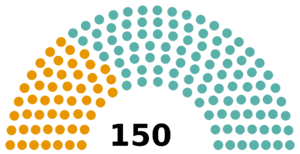Vegno electoral law
| Date: | 1722 AN |
| Subject: | "Amendments to the election system of the Assemblea Nazionale. Delegation to the Government for the determination of single-member and multi-member constituencies." |
| Country: | |
| Support: | PDC, FV, PPV, PNV, VV, PC, NM |
| Voting summary: | 146 voted for 0 abstained 4 voted against |
| Status: | Active |
The Vegnese electoral law of 1722 AN, colloquially known by the nickname "Rinaldellum bis" beacuse of Haldi Rinaldi, the author of the previous and actual law, is a parallel voting system, which acts as a mixed system, with 33,33% of seats allocated using a majority system and 66,66% using a proportional method, with one round of voting.
The electoral law was made by the Greco I Cabinet and supported in parliament by PDC, VV, PC, FV, NM and PNV, with the intention of reforming the electoral system after the great instability of the last elections. The electoral law was approved on II.1722 AN by the Parliament.
The law regulates the election of the Assemblea Nazionale, replacing the Vegno electoral law of 1708 AN.
Main characteristics and operation
The national elections use a mixed single vote into a parallel voting system, with 33,33% of seats allocated using a majority electoral system with 1 uninominal seats for each circumscription given to the most voted party or alliance and 66,66% using a proportional method, with one round of voting.
Contrary to the previous electoral law, where individual regions were considered as constituencies, in Rinaldellum bis Vegno it is divided into 50 circumscriptions based on population and in each constituency a single member seat is assigned to the candidate of the most voted alliance.
The Assemblea Nazionale is based of 150 deputies, of whom:
- 50 are elected in single-member districts (1 per each circumscription).
- 100 are elected by a national-proportional representation.
The Parliament is elected on a single ballot. The ballot includes the circumscription's member, on a purely plurality basis and the parties and party-lists were listed that supported him, which was used to determine the proportional seats, with a 3% minimum threshold for party representation.
Circumscriptions
50 circumscriptions were established on the basis of the Vegnese population:
- Region of Cossa: 8 circumscriptions
- South Coast: 2 circumscriptions
- Largoprato: 2 circumscriptions
- Bassovento: 2 circumscriptions
- Compare: 2 circumscriptions
- Mhazar-Campoasciutto: 6 circumscriptions
- Buonriposo: 5 circumscriptions
- Caponord: 3 circumscriptions
- Islands (including the regions of Falange, Falangina and Falangetta): 6 circumscriptions
- Ponente: 6 circumscriptions
- Badia: 2 circumscriptions
- Pelago: 6 circumscriptions
Voting paper
The first voting paper, which is a single one for the majority and the proportional systems, shows the names of the candidates to single-member constituencies and, in close conjunction with them, the symbols of the linked lists for the proportional part, each one with a list of the relative candidates.
Voters will be able to cast their vote in three different ways:
- Drawing a sign on the symbol of a list: in this case the vote extends to the candidate in the single-member constituency which is supported by that list.
- Drawing a sign on the name of the candidate of the single-member constituency and another one on the symbol of one list that supports the candidate: the result is the same as that described above; panachage is not permitted, meaning voters cannot vote simultaneously for a candidate in the FPTP constituency and for a party list which is not linked to that candidate.
- Drawing a sign only on the name of the candidate for the FPTP constituency, without indicating any list: in this case, the vote is valid for the candidate in the single-member constituency and also automatically extended to the list that supports them; if that candidate is however connected to several lists, the vote is divided proportionally between them, based on the votes that each one has obtained in that constituency.
In an effort to mitigate fragmentation, split-ticket voting is not allowed.
The second voting paper is for the Presidential Elections, and sees the symbol of the party with the candidate for the Presidency of the Republic; only one vote is allowed. The two most voted candidate will access the ballot.
Ballot voting paper reports only the two most voted parties with their two candidates and people can choose only one from this two.
Graphical summary

Distribution of seats in the Assemblea Nazionale.
| Assemblea Nazionale | |||
 | |||
| Method | Seats | Percentage | |
|---|---|---|---|
| Majority System | 50 | 33,33% | |
| Proportional System | 100 | 66,66% | |